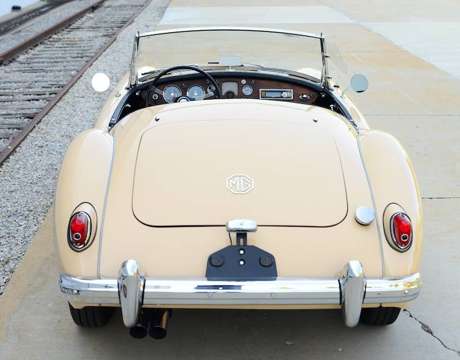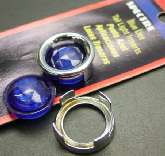The MGA With An Attitude
Blue Dot Tail Lights - AT-157
Blue dot tail lights may have been seen in the 1930's, but were particularly popular in the early 1950's (along with wide white wall tires, curb feelers, and a fox tail on the antenna). There are various theories about their purpose, from contrasting colors to better visibility in fog. But the general consensus is, they were just "cool". They were never original equipment an any car.




Like many new gadgets, they may have been legal until some law was enacted to say otherwise. In the USA these seem to be regulated by state laws, and each state is required to honor the vehicle regulations of other states when vehicles cross state lines. Some time around 1957 state (or perhaps federal) laws commonly declared that tail lights and brake lights had to be red for new production cars, but prior cars may be grandfathered in the law and still allowed to use the blue dot tail lights. Some more recent laws specifically allow the use of blue dot tail lights for street rods and custom cars, but that may require special license plates and restricted use of the vehicle. Other laws may allow blue dot lights on cars more than 40 years old, or built prior to some particular production date. You would be well advised to verify your state laws on this matter before installing these gadgets.
Aside form the "cool" factor, you may also consider the "attractive nuisance" factor. The MGA already has multiple features that attract attention. Do you really need one more item that may cause the cops to stare at your car when you are driving? It seems that cops tend to ignore these things (at least on vintage vehicles), unless they are going to stop you for some other reason (although some tickets have been issued for illegal blue lamps). Mostly they are happy if you have tail lights and brake lights (and license plate lamp) that actually light up.
Prior to 1950 tail light lenses and the blue dot jewel were commonly glass. To install the blue dot requires making a hole in the lens about an inch in diameter. For a glass lens that would require careful grinding to avoid cracking the glass. More recent lenses and blue dot jewels may be plastic. Cutting a plastic lens may be done with a drill or a hole saw, being careful not not overheat and melt the plastic. Today the blue dots are still commonly available accessory items. They seem to be installed on nearly every street rod in California, but not so common on MGAs.
|